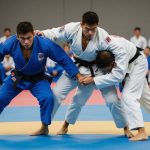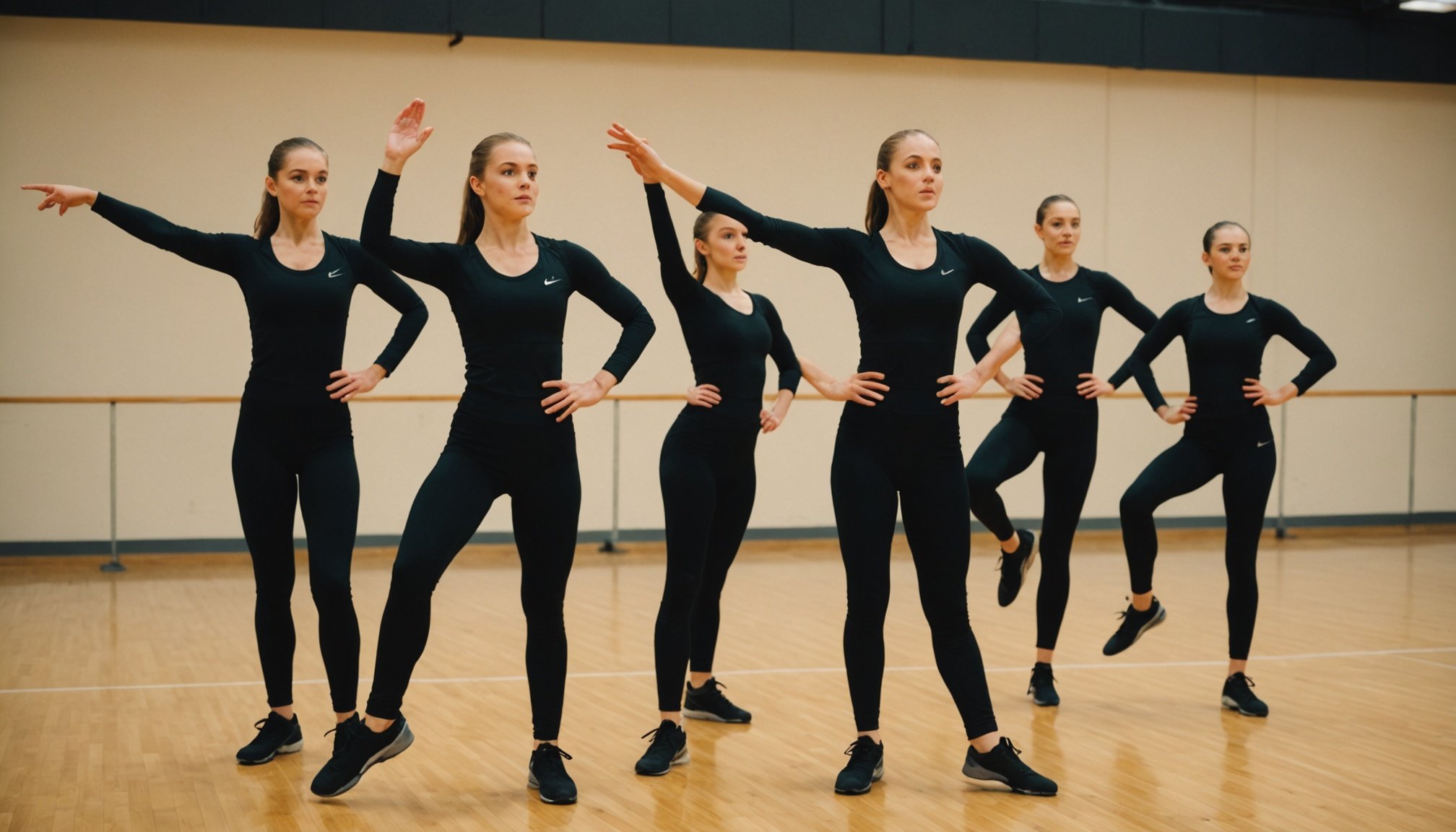Top Warm-Up Routines to Elevate Your Competitive Dance Performance
When it comes to competitive dance, the difference between a good performance and a great one often lies in the preparation. A well-structured warm-up routine is crucial for dancers to optimize their performance, prevent injuries, and ensure they are physically and mentally ready to take the stage. Here’s a comprehensive guide to help you create an effective warm-up routine that will elevate your competitive dance performance.
Why Warm Up is Essential for Dancers
Warming up is not just a preliminary step; it is a vital component of any dance training. Here are some key reasons why warming up is essential:
Also read : Unlocking Mental Wellness: The Surprising Psychological Advantages of Consistent Kayaking
Increases Blood Flow and Muscle Temperature
A good warm-up gradually increases your heart rate, which improves blood flow to your muscles. Warmer muscles are more elastic and efficient, enhancing your range of motion and overall performance.
Enhances Performance
Warming up prepares your body for the demands of intense activity. It improves coordination, reaction time, and agility, helping you perform at your best. For dancers, this means better execution of complex movements and routines.
Reduces Injury Risk
A proper warm-up can significantly reduce the risk of injuries. By preparing your muscles and joints for the stress they will encounter, you can avoid strains, sprains, and other common injuries. This is particularly important in competitive dance, where injuries can be devastating and impact your entire season.
Mental Preparation
Warming up isn’t just physical; it’s mental too. It gives you a chance to focus, set goals for your practice or performance, and get into the right mindset. A clear and focused mind is essential for delivering a confident and polished performance.
Components of a Proper Warm-Up Routine
A comprehensive warm-up routine should include several key components to ensure that your body is fully prepared for the demands of dancing.
Dynamic Stretching
Instead of static stretches, which can temporarily weaken muscles, dynamic stretching is the way to go. Focus on movements that mimic the activities you’ll be doing. For example:
- Leg swings
- Arm circles
- High knees
- Butt kicks
- Skips
These movements help increase flexibility and range of motion without the negative effects of static stretching.
Mobility Exercises
Incorporate movements that promote joint mobility. This could include:
- Hip openers
- Ankle rolls
- Shoulder rotations
Ensuring your joints are limber can enhance performance and protect against injuries. For dancers, hip openers like the low lunge and butterfly stretch are particularly beneficial for improving flexibility in the hips, glutes, and thighs.
Sport-Specific Drills
Incorporate drills that are specific to your dance style. For hip hop dancers, this could mean practicing intricate footwork or isolations. For ballet dancers, it might involve barre work or center exercises. These drills help activate the muscles you’ll be using during your performance and refine your technique.
Gradual Intensity Increase
Start at a lower intensity and gradually increase. If you’re preparing for a high-energy dance routine, begin with light cardio such as a brisk walk or some light jogging. Gradually work up to your target intensity to allow your body to adjust and reduce shock to the system.
Short, Intense Intervals
Finish your warm-up with a few short bursts of high-intensity activity. This could be sprinting, quick changes of direction, or rapid sequences of dance movements. This helps prepare your body for the intensity of the performance and gets your heart rate up to the level it will be during the actual dance.
Sample Warm-Up Routine for Dancers
Here’s a detailed warm-up routine that you can tailor to your specific dance style:
Cardiovascular Warm-Up (10-15 minutes)
- Start with 5 minutes of light cardio to get your heart rate up. This could be jogging in place, jumping jacks, or a brisk walk.
- Transition into dynamic stretching:
- Leg swings (front and back)
- Arm circles (forward and backward)
- High knees
- Butt kicks
- Skips
Mobility and Flexibility Exercises (10-15 minutes)
- Hip openers:
- Low lunge: Kneel in a deep lunge with your back leg on the floor and front knee aligned over front ankle. Hold for 30 seconds and repeat on the other side.
- Butterfly stretch: Sit on the floor with your back straight and the bottoms of your feet pressing together. Grasp your ankles or feet and slowly lower your chest toward your feet.
- Ankle rolls: Roll your ankles in both clockwise and counterclockwise directions.
- Shoulder rotations: Rotate your shoulders forward and backward in a circular motion.
Sport-Specific Drills (15-20 minutes)
- For hip hop dancers:
- Practice intricate footwork patterns.
- Work on isolations such as arm waves and chest pops.
- For ballet dancers:
- Perform barre exercises focusing on pliés, tendus, and dégagés.
- Move to center exercises like adagio and allegro.
High-Intensity Intervals (5-10 minutes)
- Finish with short bursts of high-intensity activity:
- Sprinting or rapid footwork sequences.
- Quick changes of direction or jumps.
Tips for Effective Warm-Up Routines
Here are some additional tips to make your warm-up routine more effective:
Focus on Breathing
Conscious breathing helps you relax and move deeper into each stretch. Practice moving with your breath to assist the muscles as they elongate and flex.
Consistency in Training
Just as you warm up for performances to perform at your best, warming up for practice is equally important. Consistent warm-ups help establish good habits, ensuring that your body is always ready to train effectively, regardless of the setting.
Listen to Your Body
Pay attention to any areas of discomfort or pain. If you feel tightness or soreness, spend extra time on those areas during your warm-up. This will help prevent injuries and improve your overall performance.
Cool Down and Stretch Afterward
After your dance class or performance, take the time to cool down and stretch. Static stretching at the end of exercise while the muscles are still warm helps increase overall range of motion and flexibility. This is a crucial step in maintaining flexibility and preventing muscle soreness.
Table: Comparing Different Types of Stretching
| Type of Stretching | Description | Benefits | When to Use |
|---|---|---|---|
| Dynamic Stretching | Involves moving your joints through a range of motion while keeping your muscles active. | Improves flexibility, range of motion, and prepares muscles for activity. | Before dance class or performance. |
| Static Stretching | Involves holding a stretch for a period of time. | Increases flexibility and range of motion. | After dance class or performance when muscles are warm. |
| Mobility Exercises | Focuses on joint mobility and movement. | Enhances joint flexibility and reduces injury risk. | Part of the warm-up routine to prepare joints for activity. |
Quotes from Dance Experts
-
“A proper warm-up is essential for maximizing performance and reducing the risk of injury. It’s not just about physical preparation; it’s also about mental focus and readiness,” – Abby Edwards, Strength Coach at Compete Sports Performance and Rehab.
-
“Dynamic stretching is a game-changer for dancers. It helps increase flexibility and range of motion without the negative effects of static stretching,” – Dance Teacher, Classpop!.
Practical Insights and Actionable Advice
Create a Customized Routine
Tailor your warm-up routine to your specific dance style and needs. For example, if you are a hip hop dancer, focus on drills that improve your footwork and isolations. If you are a ballet dancer, include barre and center exercises.
Incorporate Strength Training
Strength training can complement your dance training by improving your overall strength and endurance. Incorporate exercises that target your core, legs, and upper body to enhance your performance.
Cross Training
Cross training in other disciplines like yoga or Pilates can help improve your flexibility, balance, and overall dance performance. These activities can also help prevent injuries by strengthening your core and improving your body alignment.
A well-structured warm-up routine is the foundation of any successful dance performance. By incorporating dynamic stretching, mobility exercises, sport-specific drills, and gradual intensity increases, you can ensure that your body is fully prepared for the demands of competitive dance. Remember to focus on breathing, listen to your body, and cool down properly after your dance class or performance. With consistent practice and the right approach, you can elevate your competitive dance performance and achieve your goals.
In the words of a seasoned dance teacher, “The time you invest in your warm-up is the time you save in recovery and injury prevention. It’s a small price to pay for peak performance and a long, healthy dance career.” So next time you’re gearing up for a dance class or performance, take the time to warm up properly—you’ll be glad you did











